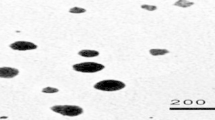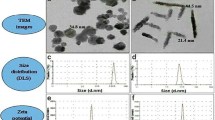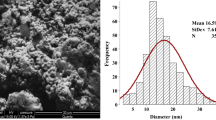Abstract
Silver nanoparticles (Ag NPs) have wide medical and industrial applications; therefore, their release into aquatic environments is a problematic issue. The present study aims to evaluate the removal efficiency of Ag NPs from water using orange peel (OP) and banana peel (BP) to moderate their toxicity on Oreochromis niloticus. Fish were divided into 4 groups: control group (dechlorinated tap water), Ag NPs (4 mg/L) exposed group, Ag NPs (4 mg/L) + OP (40 mg/L) group, and Ag NPs (4 mg/L) + BP (40 mg/L) group for 24 h, 48 h, and 96 h. The adsorptive ability of both peels was confirmed by scanning electron microscope and energy-dispersive X-ray spectroscopy after the exposure processes. The biochemical results revealed a gradual elevation in plasma glucose, total proteins, globulin, liver enzymes (AST, ALT, and ALP), creatinine, and uric acid after Ag NPs exposure, while albumin and total lipid concentrations were significantly decreased. The recorded antioxidant biomarkers in gills, and liver tissues after Ag NPs exposure showed severe oxidative damages (maximally after 96 h) as indicated by marked elevations in thiobarbituric acid reactive substances, glutathione peroxidase, catalase, and superoxide dismutase values, and decreased glutathione reduced content. All studied parameters restored more or less to that of control groups after OP and BP water treatment. The adsorbent abilities of both peels could reduce Ag NPs bioavailability and moderate their toxicological impacts.
Graphical abstract











Similar content being viewed by others
Data availability
The datasets used and/or analyzed during the current study are available from the corresponding author on reasonable request.
References
Abdel-Khalek AA (2015) Antioxidant responses and nuclear deformations in freshwater fish, Oreochromis niloticus, facing degraded environmental conditions. Bull Environ Contam Toxicol 94:701–708. https://doi.org/10.1007/s00128-015-1509-5
Abdel-Khalek AA (2016) Comparative evaluation of genotoxic effects induced by CuO bulk and nano-particles in Nile tilapia, Oreochromis niloticus. Water Air Soil Pollut 227:35. https://doi.org/10.1007/s11270-015-2737-3
Abdel-Khalek AA, Badran SR, Marie M-AS (2020a) The efficient role of rice husk in reducing the toxicity of iron and aluminum oxides nanoparticles in Oreochromis niloticus: hematological, bioaccumulation, and histological endpoints. Water Air Soil Pollut 231:53. https://doi.org/10.1007/s11270-020-4424-2
Abdel-Khalek AA, Badran SR, Marie M-AS (2020b) The effective adsorbent capacity of rice husk to iron and aluminum oxides nanoparticles using Oreochromis niloticus as a bioindicator: biochemical and oxidative stress biomarkers. Environ Sci Pollut Res 27:23159–23171. https://doi.org/10.1007/s11356-020-08906-x
Abdel-Khalek AA, Elhaddad E, Mamdouh S, Marie M-AS (2018) The chronic exposure to discharges of Sabal drain induces oxidative stress and histopathological alterations in Oreochromis niloticus. Bull Environ Contam Toxicol 101:92–98. https://doi.org/10.1007/s00128-018-2366-9
Abdel-Khalek AA, Hamed A, Marie M-AS (2016) The accumulation potency of bulk and nano zinc metal and their impacts on the hematological and histological perturbations of Oreochromis niloticus. Water Air Soil Pollut 227:206. https://doi.org/10.1007/s11270-016-2908-x
Aebi H (1984) Catalase in vitro. Methods Enzymol 105:121–126. https://doi.org/10.1016/S0076-6879(84)05016-3
Afifi M, Saddick S, Abu Zinada OA (2016) Toxicity of silver nanoparticles on the brain of Oreochromis niloticus and Tilapia zillii. Saudi J Biol Sci 23(6):754–760. https://doi.org/10.1016/j.sjbs.2016.06.008
Ahmad T, Danish M (2018) Prospects of banana waste utilization in wastewater treatment: a review. J Environ Man 206:330–348. https://doi.org/10.1016/j.jenvman.2017.10.061
Akpomie KG, Conradie J (2020) Banana peel as a biosorbent for the decontamination of water pollutants. A review. Environ Chem Lett 18:1085–1112. https://doi.org/10.1007/s10311-020-00995-x
Ale A, Rossi AS, Bacchetta C, Gervasio S, de la Torre FR, Cazenave J (2018) Integrative assessment of silver nanoparticles toxicity in Prochilodus lineatus fish. Ecol Indic 93:1190–1198. https://doi.org/10.1016/j.ecolind.2018.06.023
Anastopoulos I, Kyzas GZ (2014) Agricultural peels for dye adsorption: a review of recent literature. J Mol Liq 200:381–389. https://doi.org/10.1016/j.molliq.2014.11.006
Annadurai G, Juang RS, Lee DJ (2003) Adsorption of heavy metals from water using banana and orange peels. Water Sci Technol 47:185–190. https://doi.org/10.2166/wst.2003.0049
APHA (2005) American Water Works Association. Standard methods for the examination of water and wastewater. American Public Health Association, New York
Bacchetta C, Ale A, Simoniello MF, Gervasio S, Davico C, Rossi AS, Desimone MF, Poletta G, Lopez G, Monserrat JM, Cazenave J (2017) Genotoxicity and oxidative stress in fish after a short-term exposure to silver nanoparticles. Ecol Indic 76:230–239. https://doi.org/10.1016/j.ecolind.2017.01.018
Banaee M (2020) Alkaline phosphatase activity as a biochemical biomarker in aqua-toxicological studies. Int J Aquat Biol 8(2):143–147. https://doi.org/10.22034/ijab.v8i2.880
Banaee M, Akhlaghi M, Soltanian S, Sureda A, Gholamhosseini A, Rakhshaninejad M (2020) Combined effects of exposure to sub-lethal concentration of the insecticide chlorpyrifos and the herbicide glyphosate on the biochemical changes in the freshwater crayfish Pontastacus leptodactylus. Ecotoxicology 29(9):1500–1515. https://doi.org/10.1007/s10646-020-02233-0
Banaee M, Tahery S, Nematdoost Haghi B, Shahafve S, Vaziriyan M (2019) Blood biochemical changes in common carp (Cyprinus carpio) upon co-exposure to titanium dioxide nanoparticles and paraquat. Iran J Fish Sci 18(2):242–255 http://jifro.ir/article-1-3844-en.html
Banan A, Kalbassi MR, Bahmani M, Sotoudeh E, Johari SA, Ali JM, Kolok AS (2020) Salinity modulates biochemical and histopathological changes caused by silver nanoparticles in juvenile Persian sturgeon (Acipenser persicus). Environ Sci Pollut Res 27:10658–10671. https://doi.org/10.1007/s11356-020-07687-7
Bartles H, Bohmer M, Heirli C (1972) Serum creatinine determination without protein precipitation. Clin Chim Acta 37:193–197. https://doi.org/10.1016/0009-8981(72)90432-9
Belfield A, Goldberg DM (1971) Revised assay for serum phenyl phosphatase activity using 4-amino-antipyrine. Enzyme 12:561–573. https://doi.org/10.1159/000459586
Benavides M, Fernández-Lodeiro J, Coelho P, Lodeiro C, Diniz MS (2016) Single and combined effects of aluminum (Al2O3) and zinc (ZnO) oxide nanoparticles in a freshwater fish, Carassius auratus. Environ Sci Pollut Res 23:24578–24591. https://doi.org/10.1007/s11356-016-7915-3
Besnaci S, Bensoltane S, Zerari L, Samia C, Hamlet SA, Berrebbah H (2016) Impact of nanometric iron oxide in the hepatopancreas of terrestrial gastropod Helix Aspersa: histological changes and biochemical parameters. Int J Pharm Sci Rev Res 36:234–241. https://doi.org/10.13140/RG.2.2.10749.92644
Beutler E, Duron O, Kelly MB (1963) Improved method for the determination of blood glutathione. J Lab Clin Med 61:882–888
Chae YJ, Pham CH, Lee J, Bae E, Yi J, Gu MB (2009) Evaluation of the toxic impact of silver nanoparticles on Japanese medaka (Oryzias latipes). Aquat Toxicol 94:320–327. https://doi.org/10.1016/j.aquatox.2009.07.019
Doumas BT, Watson WA, Biggs HG (1971) Albumin standards and the measurement of serum albumin with bromocresol green. Clin Chim Acta 31:87–96. https://doi.org/10.1016/0009-8981(71)90365-2
Eslamloo K, Akhavan SR, Fallah FJ, Henry MA (2014) Variations of physiological and innate immunological responses in goldfish (Carassius auratus) subjected to recurrent acute stress. Fish Shellfish Immunol 37:147–153. https://doi.org/10.1016/j.fsi.2014.01.014
Farmen E, Mikkelsen HN, Evensen Ø, Einset J, Heier LS, Rosseland BO, Salbu B, Tollefsen KE, Oughton DH (2012) Acute and sub-lethal effects in juvenile Atlantic salmon exposed to low μg/L concentrations of Ag nanoparticles. Aquat Toxicol 108:78–84. https://doi.org/10.1016/j.aquatox.2011.07.007
Gornal AC, Bardawill CJ, David MM (1949) Determination of serum proteins by means of the Biuret reaction. J Biol Chem 177:751–766
Govindasamy R, Rahuman AA (2012) Histopathological studies and oxidative stress of synthesized silver nanoparticles in Mozambique tilapia (Oreochromis mossambicus). J Environ Sci 24:1091–1098. https://doi.org/10.1016/S1001-0742(11)60845-0
Hajirezaee S, Mohammadi G, Naserabad SS (2020) The protective effects of vitamin C on common carp (Cyprinus carpio) exposed to titanium oxide nanoparticles (TiO2-NPs). Aquaculture 518:734734. https://doi.org/10.1016/j.aquaculture.2019.734734
Hao L, Chen L (2012) Oxidative stress responses in different organs of carp (Cyprinus carpio) with exposure to ZnO nanoparticles. Ecotoxicol Environ Saf 80:103–110. https://doi.org/10.1016/j.ecoenv.2012.02.017
Ibrahim ATA, Banaee M, Sureda A (2021) Genotoxicity, oxidative stress, and biochemical biomarkers of exposure to green synthesized cadmium nanoparticles in Oreochromis niloticus (L.). Comp Biochem Physiol C Toxicol Pharmacol 242:108942. https://doi.org/10.1016/j.cbpc.2020.108942
Javed M, Ahmad MI, Usmani N, Ahmad M (2017) Multiple biomarker responses (serum biochemistry, oxidative stress, genotoxicity and histopathology) in Channa punctatus exposed to heavy metal loaded waste water. Sci Rep 7:1675–1685. https://doi.org/10.1038/s41598-017-01749-6
Jozefczak M, Remans T, Vangronsveld J, Cuypers A (2012) Glutathione is a key player in metal-induced oxidative stress defenses. Int J Mol Sci 13:3145–3175. https://doi.org/10.3390/ijms13033145
Kanwal Z, Raza MA, Manzoor F, Riaz S, Jabeen G, Fatima S, Naseem S (2019) A comparative assessment of nanotoxicity induced by metal (Silver, Nickel) and metal oxide (Cobalt, Chromium) nanoparticles in Labeo rohita. Nanomaterials 9:309–328. https://doi.org/10.3390/nano9020309
Khan MS, Qureshi NA, Jabeen F, Shakeel M, Asghar MS (2018) Assessment of waterborne amine-coated silver nanoparticle (Ag-NP)-induced toxicity in labeo rohita by histological and hematological profiles. Biol Trace Elem Res 182:130–139. https://doi.org/10.1007/s12011-017-1080-5
Khosravi-Katuli K, Shabani A, Paknejad H, Imanpoor MR (2018) Comparative toxicity of silver nanoparticle and ionic silver in juvenile common carp (Cyprinus carpio): accumulation, physiology and histopathology. J Hazard Mater 359:373–381. https://doi.org/10.1016/j.jhazmat.2018.07.064
Kittler S, Greulich C, Diendorf J, Kӧller M, Epple M (2010) Toxicity of silver nanoparticles increases during storage because of slow dissolution under release of silver ions. Chem Mater 22:4548–4554. https://doi.org/10.1021/cm100023p
Knight JA, Rawle JM, Anderson S (1972) Chemical basis of sulfo-phospho-vanillin reaction for estimating total serum lipids. Clin Chem 18:199–202
Liang S, Guo X, Feng N, Tian Q (2010) Isotherms, kinetics and thermodynamic studies of adsorption of Cu2+ from aqueous solutions by Mg2+/K+ type orange peel adsorbents. J Hazard Mater 174:756–762. https://doi.org/10.1016/j.jhazmat.2009.09.116
Mahmoud UM, Mekkawy IAA, Naguib M, Sayed AE-DH (2019) Silver nanoparticle–induced nephrotoxicity in Clarias gariepinus: physio-histological biomarkers. Fish Physiol Biochem 45:1895–1905. https://doi.org/10.1007/s10695-019-00686-7
Naguib M, Mahmoud UM, Mekkawy IA, Sayed AE-DH (2020) Hepatotoxic effects of silver nanoparticles on Clarias gariepinus; biochemical, histopathological, and histochemical studies. Toxicol Rep 7:133–141. https://doi.org/10.1016/j.toxrep.2020.01.002
Navarro E, Piccapietra F, Wagner B, Marconi F, Kaegi R, Odzak N, Sigg L, Behra R (2008) Toxicity of silver nanoparticles to Chlamydomonas reinhardtii. Environ Sci Technol 42:8959–8964. https://doi.org/10.1021/es801785m
Neugebauer EA, Sans Cartier GL, Wakeford BJ (2000) Methods for the determination of metals in wildlife tissues using various atomic absorption spectrophotometry techniques. Technical Report Series No. 337E. Canadian Wildlife Service, Headquarters, Hull http://citeseerx.ist.psu.edu/viewdoc/download?doi=10.1.1.578.2937&rep=rep1&type=pdf
Nishikimi M, Appaji N, Yagi K (1972) The occurrence of superoxide anion in the reaction of reduced phenazine methosulfate and molecular oxygen. Biochem. Biophys Res Common 46:849–854. https://doi.org/10.1016/S0006-291X(72)80218-3
Ohkawa H, Ohishi N, Yagi K (1979) Assay for lipid peroxides in animal tissues by thiobarbituric acid reaction. Anal Biochem 95:351–358. https://doi.org/10.1016/0003-2697(79)90738-3
Oyewo OA, Onyango MS, Wolkersdorfer C (2018) Lanthanides removal from mine water using banana peels nanosorbent. Int J Environ Sci Technol 15:1265–1274. https://doi.org/10.1007/s13762-017-1494-9
Paglia DE, Valentine WN (1967) Studies on the quantitative and qualitative characterization of erythrocyte glutathione peroxidase. J Lab Clin Med 70:158–169
Prætorius E, Poulsen H (1953) Enzymatic determination of uric acid with detailed directions. Scand J Clin Lab Inv 5:273–280. https://doi.org/10.3109/00365515309094197
Pulit-Prociak J, Banach M (2016) Silver nanoparticles - a material of the future...? Open Chem 14:76–91. https://doi.org/10.1515/chem-2016-0005
Reitman S, Frankel S (1957) A colorimetric method for the determination of serum glutamic oxalacetic and glutamic pyruvic transaminases. Am J Clin Pathol 28:56–63. https://doi.org/10.1093/ajcp/28.1.56
Safa Y, Bhatti HN (2011) Adsorptive removal of direct textile dyes by low cost agricultural waste: application of factorial design analysis. Chem Eng J 167:35–41. https://doi.org/10.1016/j.cej.2010.11.103
Sarkar B, Jaisai M, Mahanty A, Panda P, Sadique M, Nayak BB, Gallardo G, Thakur D, Bhattacharjee S, Dutta J (2015) Optimization of the sublethal dose of silver nanoparticle through evaluating its effect on intestinal physiology of Nile tilapia (Oreochromis niloticus L.). J Environ Sci Health 50:814–823. https://doi.org/10.1080/10934529.2015.1019800
Singh NB, Nagpal G, Agrawal S, Rachna (2018) Water purification by using adsorbents: a review. Environ Technol Innovat 11:187–240. https://doi.org/10.1016/j.eti.2018.05.006
Taju G, Abdul Majeed S, Nambi KSN, Sahul Hameed AS (2014) In vitro assay for the toxicity of silver nanoparticles using heart and gill cell lines of Catla catla and gill cell line of Labeo rohita. Comp Biochem Physiol – part C: Toxicol Pharmacol 161:41–52. https://doi.org/10.1016/j.cbpc.2014.01.007
Tortella GR, Rubilar O, Durán N, Diez MC, Martínez M, Parada J, Seabra AB (2020) Silver nanoparticles: toxicity in model organisms as an overview of its hazard for human health and the environment. J Hazard Mater 390:121974. https://doi.org/10.1016/j.jhazmat.2019.121974
Trinder P (1969) Determination of glucose in blood using glucose oxidase with an alternative oxygen acceptor. Ann Clin Biochem 6:24–27 https://journals.sagepub.com/doi/pdf/10.1177/000456326900600108
Zeumer R, Galhano V, Monteiro MS, Kuehr S, Knopf B, Meisterjahna B, Soares AMVM, Loureiro S, Lopes I, Schlechtriem C (2020) Chronic effects of wastewater-borne silver and titanium dioxide nanoparticles on the rainbow trout (Oncorhynchus mykiss). Sci Tot Environ 723:137974. https://doi.org/10.1016/j.scitotenv.2020.137974
Zhu R, Chen Q, Zhou Q, Xi Y, Zhu J, He H (2016) Adsorbents based on montmorillonite for contaminant removal from water: a review. Appl Clay Sci 123:239–258. https://doi.org/10.1016/j.clay.2015.12.024
Acknowledgements
The authors extend their appreciation to the Zoology department, Faculty of Science, Cairo University, Egypt for supporting the present study.
Funding
Faculty of Science, Cairo University funded the present study through the analysis and interpretation of data.
Author information
Authors and Affiliations
Contributions
All authors contributed to the study conception and design. Material preparation, data collection, and analysis were performed by Amr Adel Abdel-Khalek, Aliaa Hamed, and Wafaa S.F. Hasheesh. The first draft of the manuscript was written by Amr Adel Abdel-Khalek and all authors commented on previous versions of the manuscript. All authors read and approved the final manuscript.
Corresponding author
Ethics declarations
Ethics approval
All procedures performed in the current work involving fish were approved with approval no. CU I F 2019 and were following the ethical standards of the Faculty of Science, Cairo University, Institutional Animal Care and Use Committee (IACUC) at which the studies were conducted.
Consent to participate
All authors read and approved the final manuscript.
Code availability
Not applicable
Consent for publication
Not applicable.
Competing interests
The authors declare no competing interests.
Additional information
Responsible Editor: Bruno Nunes
Publisher’s note
Springer Nature remains neutral with regard to jurisdictional claims in published maps and institutional affiliations.
Rights and permissions
About this article
Cite this article
Abdel-Khalek, A.A., Hamed, A. & Hasheesh, W.S. Does the adsorbent capacity of orange and banana peels toward silver nanoparticles improve the biochemical status of Oreochromis niloticus?. Environ Sci Pollut Res 28, 33445–33460 (2021). https://doi.org/10.1007/s11356-021-13145-9
Received:
Accepted:
Published:
Issue Date:
DOI: https://doi.org/10.1007/s11356-021-13145-9




